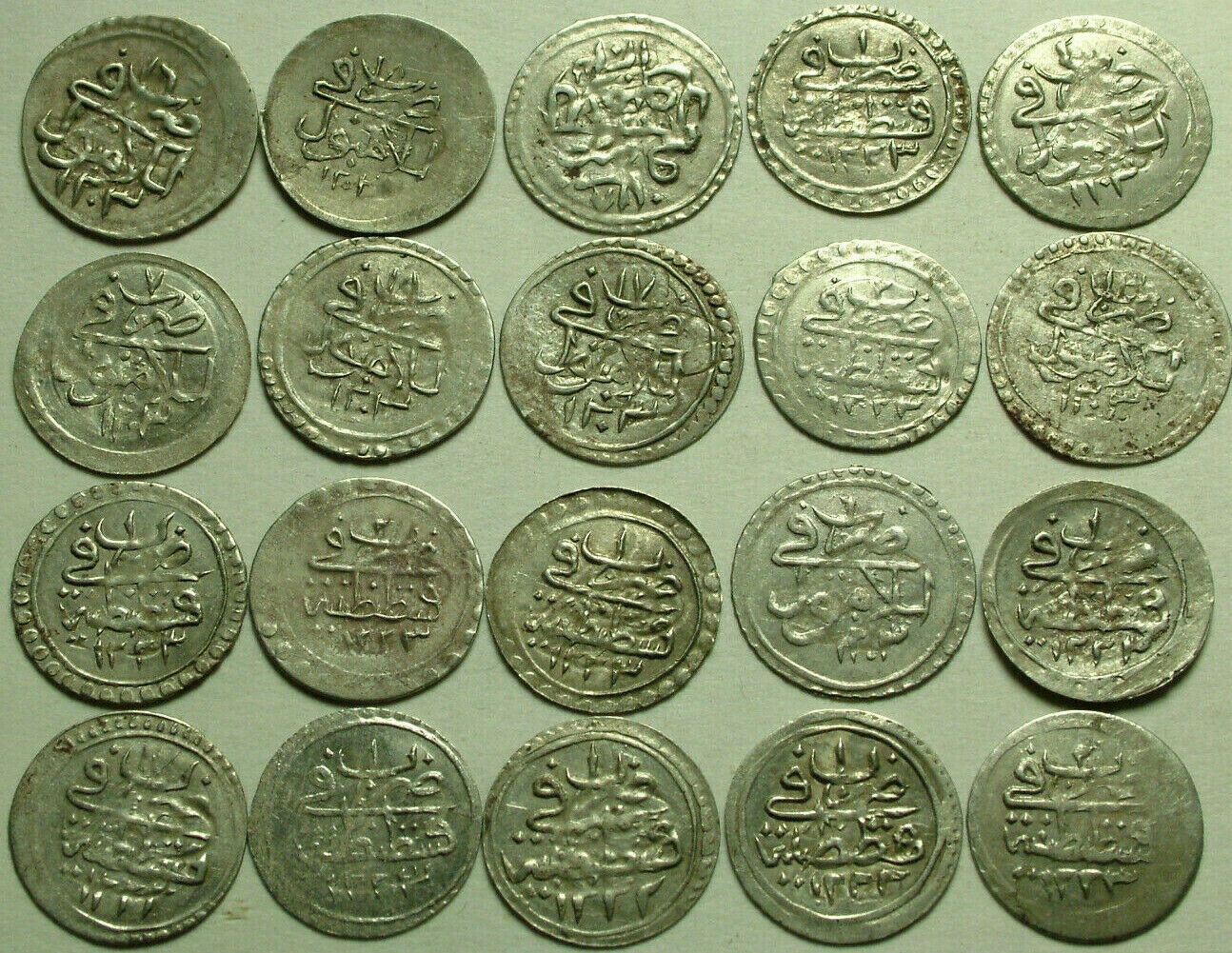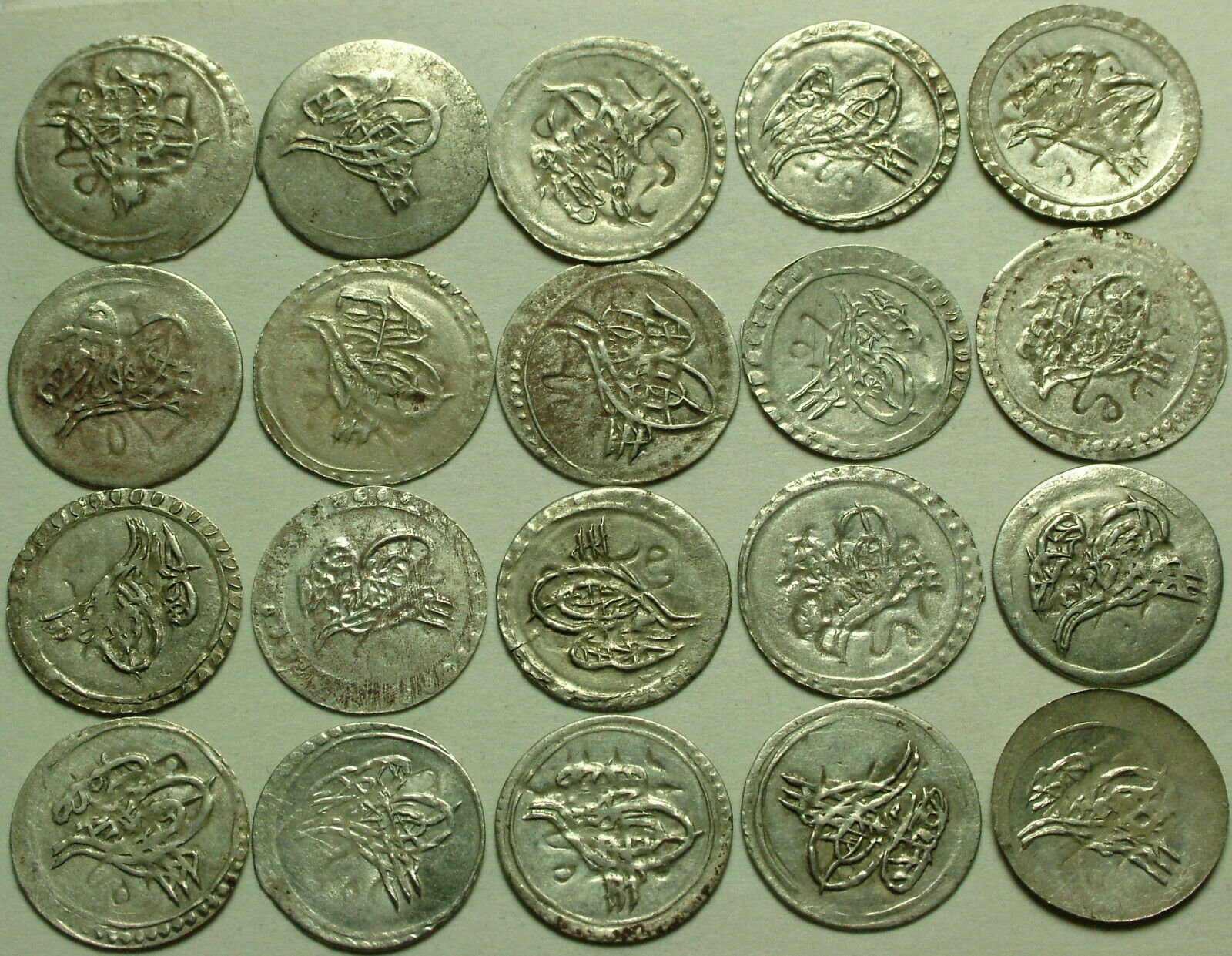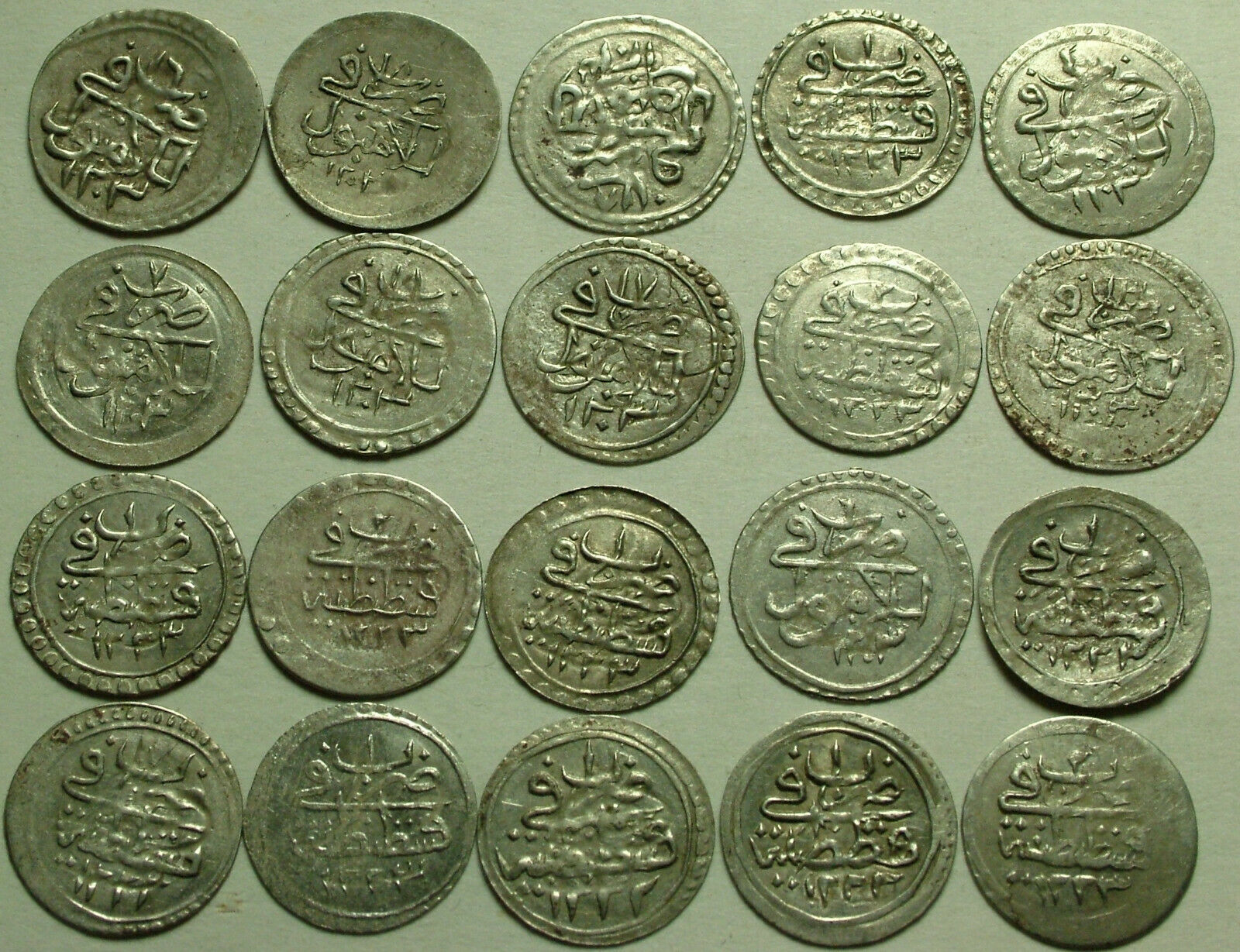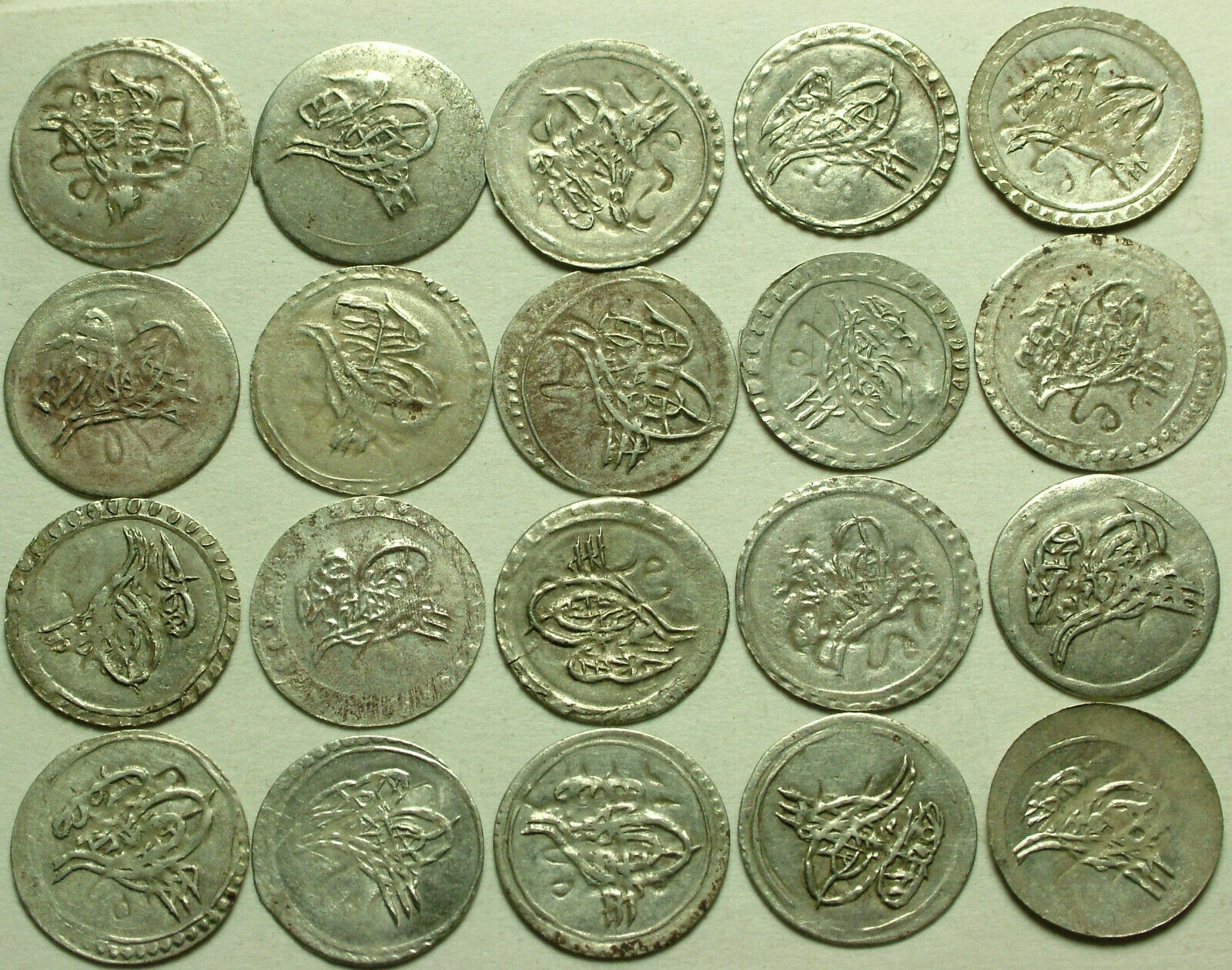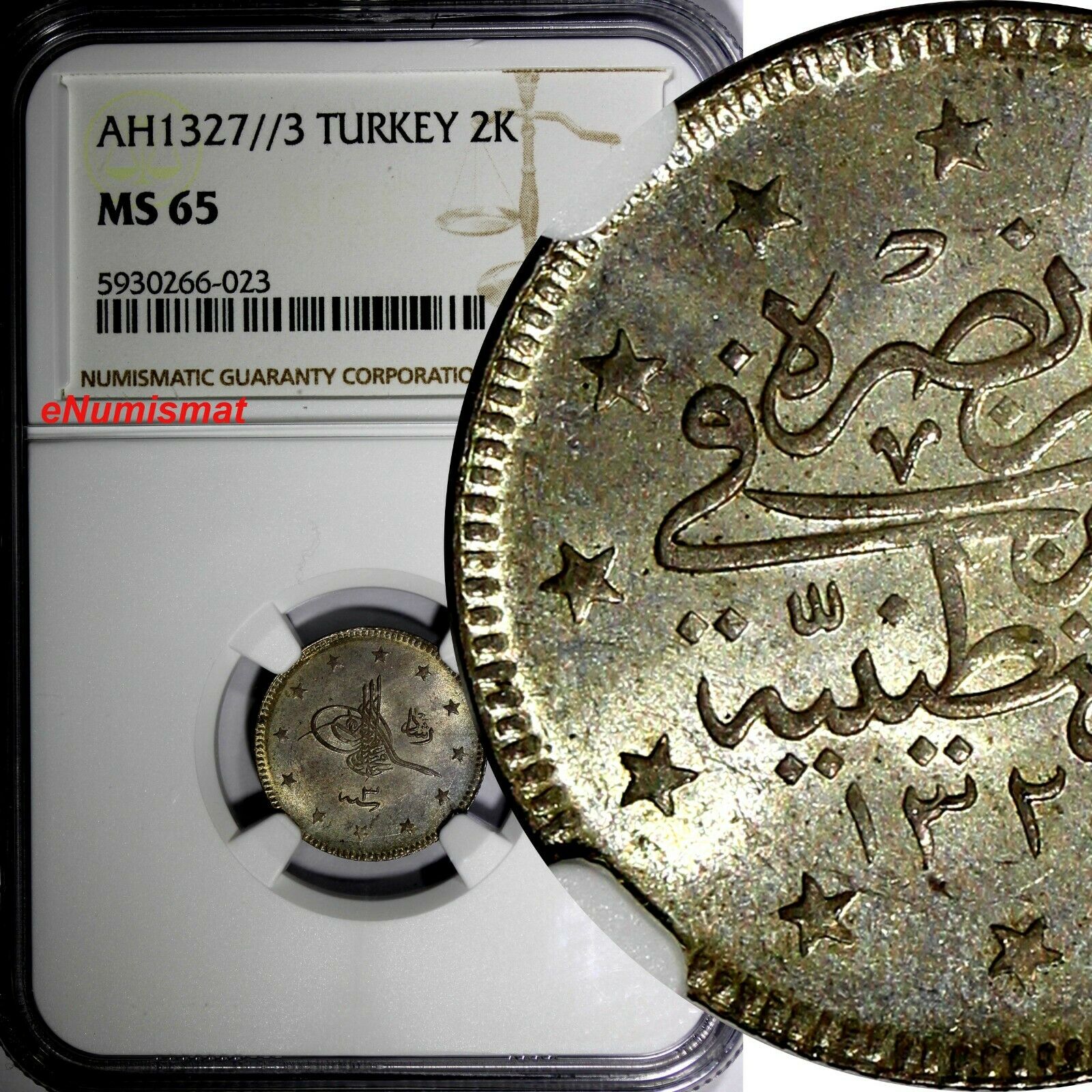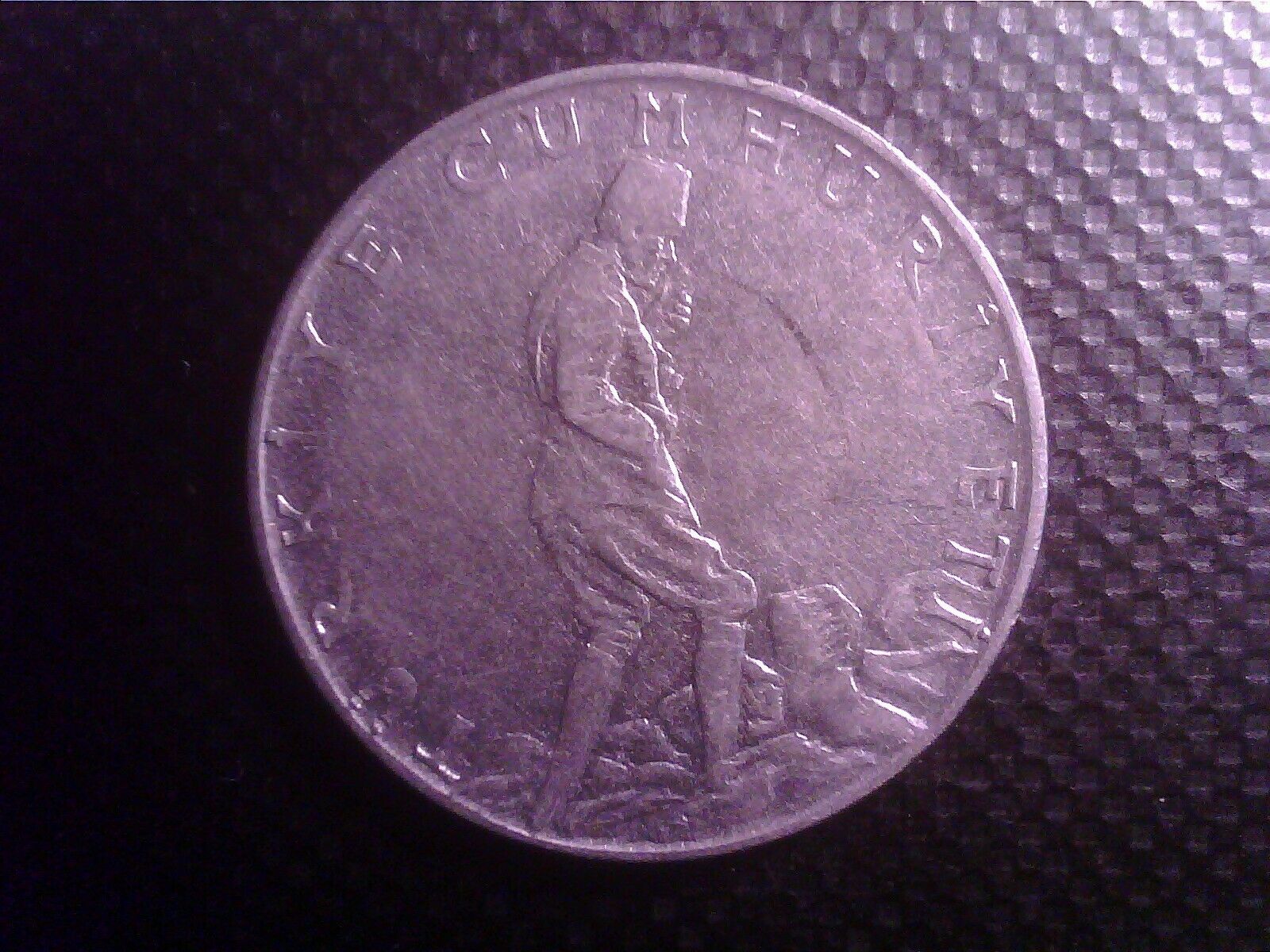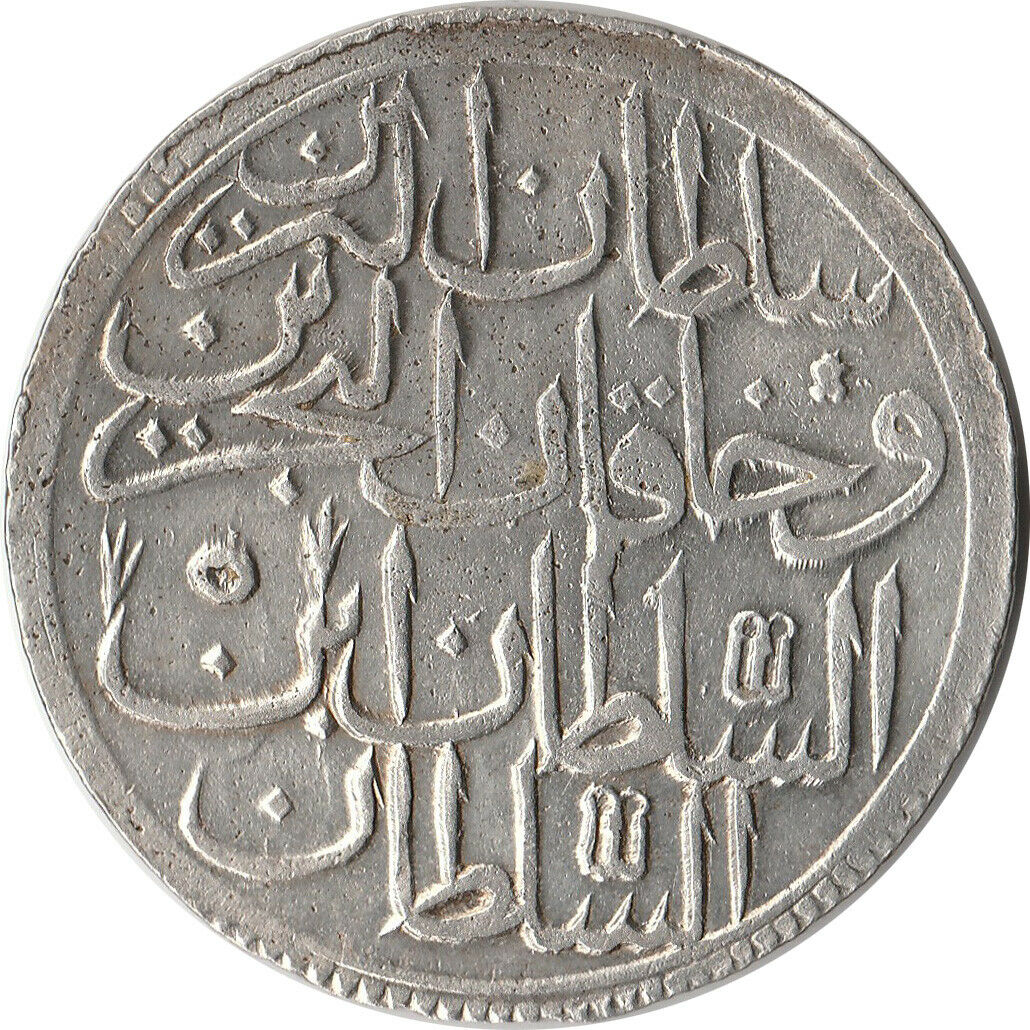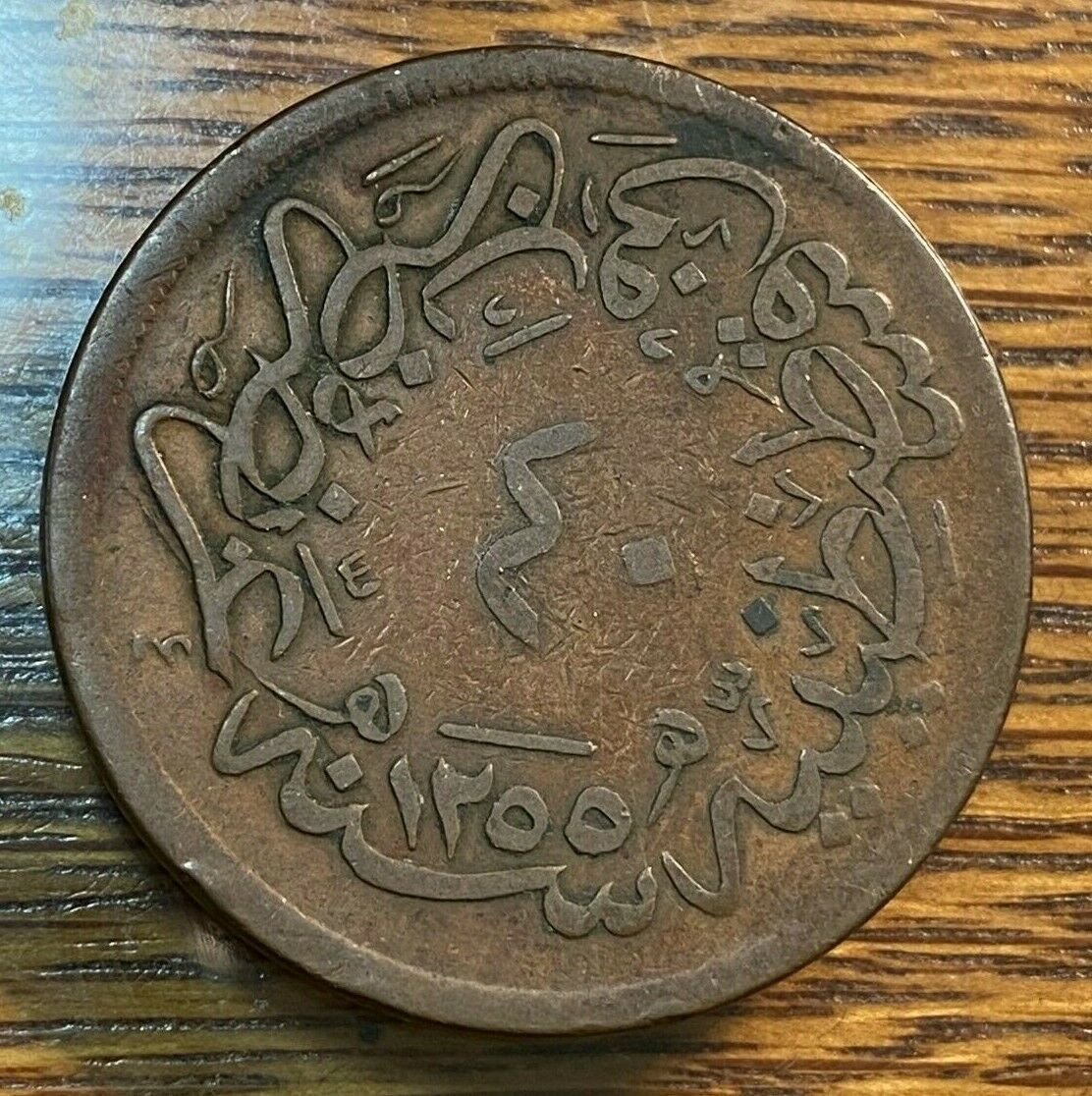-40%
Rare genuine Islamic silver Para coin/Ottoman Empire/Turkey Selim Mahmud Mustafa
$ 15.57
- Description
- Size Guide
Description
One genuine authentic Islamic silver coin of Ottoman EmpireOttoman Empire - Turkey Istambul
Bidding is for random coin from the lot pictured.
Authenticity guaranteed!! 1 bod for 1 coin
Ottoman coin
measuring
14-15mm. in diameter.
(VF) Original tone.
Rare and interesting as pictured.
No holes!!! In superb quality. Rare to find in this state.
Authenticity guaranteed. ORIGINAL ISLAMIC COIN.
Coins are in good condition and very rare and nice inclusion to the finest collectio
n
.
You are bidding on the exact ANCIENT ISLAMIC coin pictured and described above.
Mustafa IV 1807-1808AD
MAHMUD II AH1223 (1808AD)
Selim III 1203AH (1789AD)
Selim III (Ottoman Turkish: سليم ثالث Selīm-i sālis) (24 December 1761 – 28 July 1808) was the reform-minded Sultan of the Ottoman Empire from 1789 to 1807. The Janissaries eventually deposed and imprisoned him, and placed his cousin Mustafa on the throne as Mustafa IV. Selim was subsequently killed by a group of assassins.
Selim III was the son of Sultan Mustafa III and his wife Mihrişah Sultan. His mother Mihrişah Sultan originated in Georgia and when she became the Valide Sultan, she participated in reforming the government schools and establishing political corporations. His father Ottoman Sultan Mustafa III was very well educated and believed in the necessity of reforms. Mustafa III attempted to create a powerful army during the peacetime with professional, well-educated soldiers. This was primarily motivated by his fear of a Russian invasion. During the Russo-Turkish War he fell ill and died of a heart attack in 1774. Sultan Mustafa was aware of the fact that a military reform was necessary. He declared new military regulations and opened maritime and artillery academies.
Sultan Mustafa was very influenced by mysticism. Oracles predicted his son Selim would be a world-conqueror, so he organized a joyous feast lasting seven days. Selim was very well educated in the palace. Sultan Mustafa III bequeathed his son as his successor; however, Selim's uncle Abdul Hamid I ascended the throne after Mustafa's death. Sultan Abdul Hamid I took care of Selim and put great emphasis on his education.
After Abdul Hamid's death Selim succeeded him on 7 April 1789, not yet 27 years old. Sultan Selim III was very fond of literature and calligraphy; many of his works were put on the walls of mosques and convents. He wrote many poems, especially about Crimea's occupation by Russia. He spoke Arabic and Persian fluently. Selim III was very religious, and very patriotic. He was a poet, a musician and very fond of fine arts.
Selim was a very modern man and a reformist ruler.
Mustafa IV (/ˈmʊstəfə/; Ottoman Turkish: مصطفى رابع Muṣṭafā-yi rābi‘; 8 September 1779 – 16 November 1808) was the Sultan of the Ottoman Empire from 1807 to 1808.
Mustafa IV was born on 8 September 1779 in Constantinople. He was the son of Sultan Abdul Hamid I (1774–1789) and Sineperver Sultan.
Both he and his brother, Mahmud II, were the last remaining male members of the house of Osman I after their cousin, the reformist Sultan Selim III (1789–1807). They alone were therefore eligible to inherit the throne from Selim, by whom they were treated favorably. Since Mustafa was the elder, he took precedence over his brother to the throne. During his short reign, Mustafa would both save his cousin's life, and order him murdered. Mustafa was Sultan Selim III's favourite crown prince, but he deceived his cousin and co-operated with the rebels to take his throne.
Mustafa ascended to the throne after the deposition of his cousin, Selim, on 29 May 1807. He came to the throne in the wake of the turbulent events that led to the fatwa against Selim for "introduce[ing] among the Moslems the manners of infidels and show[ing] an intention to suppress the Janissaries." Selim fled to the palace, where he swore fealty to his cousin as the new sultan, and attempted to commit suicide. Mustafa spared his life by smashing the cup of poison that his cousin attempted to drink.
Mustafa's brief reign was turbulent. Immediately upon ascending to the throne, the Janissaries rioted throughout Constantinople, looting and murdering anyone who appeared to support Selim. More threatening, however, was a truce signed with the Russians, which freed Mustafa Bayrakdar, a pro-reformist commander stationed on the Danube to march his army back to Constantinople in an effort to restore Selim. With the aid of the Grand Vizier of Adrianople, the army marched on the capital and seized the palace.
Sarıbeyzade Aleko, the interpreter of Fenerli Divan-ı Hümayun, was executed on 11 September 1807 because he was involved in spying on government affairs that were not related to his job. It was written that he gave the betrayal and state secrets to the enemy in the label hanging around his neck. This execution tightened Ottoman-French relations. French envoy Sebastiani protested the execution of Aleko, who was under the patronage of the government by going to Babıali. After the cease-fire agreement signed in the Russian lada and the turmoil in the Silistra army, the Ottoman troops returned to Edirne, who had no army character left.
Meanwhile in Istanbul and Edirne, after a long winter, centre frosts were experienced, shortages and wood shortages were experienced. The situation of the troops and the cadre of Edirne was devastated. Soldiers were asked to dispatch soldiers from the provincial governors, until only a exquisite number of soldiers had come from a few places near Istanbul such as Izmit and Şile. The pro-Nizam-ı Cedid protestors in Anatolia and Çapanoğlu Süleyman Bey, in the first place, had cut all kinds of aid towards Istanbul.
Attempting to secure his position by positing himself as the only surviving heir of Osman, Mustafa ordered both Selim and his brother Mahmud murdered at Topkapı Palace, Constantinople. He then ordered his guards to show the rebels Selim's body, and they promptly tossed it into the inner courtyard of the palace. Mustafa then ascended his throne, assuming that Mahmud was also dead, but the prince had been hiding in the furnace of a bath. Just as the rebels demanded that Mustafa "yield his place to a worthier," Mahmud revealed himself, and Mustafa was deposed. The failure of his short reign prevented the efforts to undo the reforms, which continued under Mahmud.
Mahmud II
(
Ottoman Turkish
:
Mahmud-i
s
ani
)
(20 July 1785 – 1 July 1839)
was the 30th
Sultan
of the
Ottoman Empire
from 1808 until his death in 1839. He was born in the
Topkapi Palace
,
Constantinople
, the son of Sultan
Abdulhamid I
. His reign is notable mostly for the extensive administrative, military and fiscal reforms he instituted, which culminated into the Decree of
Tanzimat
(Reorganization) that was carried out by his sons
Abdülmecid I
and
Abdülaziz I
. His mother was
Valide Sultan
Naksh-i-Dil Haseki
(there have been speculations that she was a cousin of
Napoleon
's wife
Josephine
, but this is now widely regarded as false; see
Aimée du Buc de Rivéry
).
Accession
In 1808, Mahmud II's predecessor (and half-brother)
Mustafa IV
(1807–08) ordered his execution along with his cousin, the deposed Sultan
Selim III
(1789–1807), in order to defuse the rebellion. Selim III was killed, but Mahmud was safely kept hidden by his mother and was placed on the throne after the rebels deposed Mustafa IV. The leader of this rebellion,
Mustafa Bayrakdar
, then became Mahmud II's
vizier
.
There are many stories surrounding the circumstances of his attempted murder. A version by the 19th century Ottoman historian Cevdet Pasha gives the following account: one of his slaves, a
Georgian
girl named Cevri, gathered ashes when she heard the commotion in the palace surrounding the murder of Selim III. When the assassins approached the Harem chambers where Mahmud was staying, she was able to keep them away for a while by throwing ashes into their faces, temporary blinding them. This allowed Mahmud to escape through a window and climb onto the roof of the Harem. He apparently ran to the roof of the Third Court where other pages saw him and helped him come down with pieces of clothes that were quickly tied together as a ladder. By this time one of the leaders of the rebellion,
Alemdar Mustafa Pasha
arrived with his armed men and upon seeing the dead body of Selim III proclaimed Mahmud as
padishah
. The slave girl Cevri Kalfa was awarded for her bravery and loyalty and appointed
haznedar usta
, the chief treasurer of the imperial Harem, which was the second most important position in the hierarchy. A plain stone staircase at the
Altinyol
(Golden Way) of the Harem is called Staircase of Cevri (Jevri) Kalfa, since the events apparently happened around there and are associated with her.
Reign overview
The vizier took the initiative in resuming reforms that had been terminated by the conservative
coup
of 1807 that had
brought Mustafa IV to power
. However, soon the vizier was killed by Ibrahim's army, and Mahmud II temporarily abandoned the reforms. Mahmud II's later reformation efforts were more successful.
During the early years of Mahmud II's reign, his governor of Egypt
Mehmet Ali Pasa
successfully reconquered the holy cities of
Medina
(1812) and
Mecca
(1813) from the
Nejdi rebels
.
His reign also marked the first breakaway from the Ottoman Empire, with Greece gaining its
independence
following a rebellion that started in 1821. In 1827 the combined British, French and Russian navies defeated the Ottoman Navy at the
Battle of Navarino
; in the aftermath, the Ottoman Empire was forced to recognize Greece with the
Treaty of Constantinople
in July 1832. This event, together with the occupation of the Ottoman province of
Algeria
by
France
in 1830, marked the beginning of the gradual break-up of the Ottoman Empire. Non-Turkish ethnic groups living in the empire's territories, especially in Europe, started their own independence movements.
Among Mahmud II's most notable acts during his reign was the abolition of the
Janissary
corps in 1826, permitting the establishment of a European-style conscript army, recruited largely from Turkish speakers of Rumelia and Asia Minor. Mahmud was also responsible for the subjugation of the
Iraqi Mamluks
in 1831. He ordered the execution of the renowned
Ali Pasha
of
Tepelena
, an 80-year-old man, for condemning
The Auspicious Incident
. He sent his
Grand Vizier
to execute the
Bosnian Muslim
hero
Husein Gradašcevic
.
He began preparations for the
Tanzimat
reforms in 1839. The Tanzimat marked the beginning of modernization in
Turkey
, and had immediate effects on social and legal aspects of life in the Empire, such as European style clothing, architecture, legislation, institutional organization and land reform.
He was concerned also for aspects of tradition. He made great efforts to revive the sport of archery. He ordered his archery student, Mustafa Kani, to write a book about the history, construction, and use of
Turkish bows
, from which comes most of what is now known of Turkish bowyery.
Mahmud II died of
tuberculosis
- some say he was murdered - at the
Esma Sultana Palace
\P
Çamlica
, in 1839. His funeral was attended by crowds of people who came to bid the Sultan farewell. His son
Abdülmecid
succeeded him.
Mahmud II
(
Ottoman Turkish
: ????? ????
Mahmud-i
s
ani
)
(20 July 1785 – 1 July 1839)
was the 30th
Sultan
of the
Ottoman Empire
from 1808 until his death in 1839. He was born in the
Topkapi Palace
,
Constantinople
, the son of Sultan
Abdulhamid I
. His reign is notable mostly for the extensive administrative, military and fiscal reforms he instituted, which culminated into the Decree of
Tanzimat
(Reorganization) that was carried out by his sons
Abdülmecid I
and
Abdülaziz I
. His mother was
Valide Sultan
Naksh-i-Dil Haseki
(there have been speculations that she was a cousin of
Napoleon
's wife
Josephine
, but this is now widely regarded as false; see
Aimée du Buc de Rivéry
).
Accession
In 1808, Mahmud II's predecessor (and half-brother)
Mustafa IV
(1807–08) ordered his execution along with his cousin, the deposed Sultan
Selim III
(1789–1807), in order to defuse the rebellion. Selim III was killed, but Mahmud was safely kept hidden by his mother and was placed on the throne after the rebels deposed Mustafa IV. The leader of this rebellion,
Mustafa Bayrakdar
, then became Mahmud II's
vizier
.
There are many stories surrounding the circumstances of his attempted murder. A version by the 19th century Ottoman historian Cevdet Pasha gives the following account: one of his slaves, a
Georgian
girl named Cevri, gathered ashes when she heard the commotion in the palace surrounding the murder of Selim III. When the assassins approached the Harem chambers where Mahmud was staying, she was able to keep them away for a while by throwing ashes into their faces, temporary blinding them. This allowed Mahmud to escape through a window and climb onto the roof of the Harem. He apparently ran to the roof of the Third Court where other pages saw him and helped him come down with pieces of clothes that were quickly tied together as a ladder. By this time one of the leaders of the rebellion,
Alemdar Mustafa Pasha
arrived with his armed men and upon seeing the dead body of Selim III proclaimed Mahmud as
padishah
. The slave girl Cevri Kalfa was awarded for her bravery and loyalty and appointed
haznedar usta
, the chief treasurer of the imperial Harem, which was the second most important position in the hierarchy. A plain stone staircase at the
Altinyol
(Golden Way) of the Harem is called Staircase of Cevri (Jevri) Kalfa, since the events apparently happened around there and are associated with her.
Reign overview
The vizier took the initiative in resuming reforms that had been terminated by the conservative
coup
of 1807 that had
brought Mustafa IV to power
. However, soon the vizier was killed by Ibrahim's army, and Mahmud II temporarily abandoned the reforms. Mahmud II's later reformation efforts were more successful.
During the early years of Mahmud II's reign, his governor of Egypt
Mehmet Ali Pasa
successfully reconquered the holy cities of
Medina
(1812) and
Mecca
(1813) from the
Nejdi rebels
.
His reign also marked the first breakaway from the Ottoman Empire, with Greece gaining its
independence
following a rebellion that started in 1821. In 1827 the combined British, French and Russian navies defeated the Ottoman Navy at the
Battle of Navarino
; in the aftermath, the Ottoman Empire was forced to recognize Greece with the
Treaty of Constantinople
in July 1832. This event, together with the occupation of the Ottoman province of
Algeria
by
France
in 1830, marked the beginning of the gradual break-up of the Ottoman Empire. Non-Turkish ethnic groups living in the empire's territories, especially in Europe, started their own independence movements.
Among Mahmud II's most notable acts during his reign was the abolition of the
Janissary
corps in 1826, permitting the establishment of a European-style conscript army, recruited largely from Turkish speakers of Rumelia and Asia Minor. Mahmud was also responsible for the subjugation of the
Iraqi Mamluks
in 1831. He ordered the execution of the renowned
Ali Pasha
of
Tepelena
, an 80-year-old man, for condemning
The Auspicious Incident
. He sent his
Grand Vizier
to execute the
Bosnian Muslim
hero
Husein Gradašcevic
.
He began preparations for the
Tanzimat
reforms in 1839. The Tanzimat marked the beginning of modernization in
Turkey
, and had immediate effects on social and legal aspects of life in the Empire, such as European style clothing, architecture, legislation, institutional organization and land reform.
He was concerned also for aspects of tradition. He made great efforts to revive the sport of archery. He ordered his archery student, Mustafa Kani, to write a book about the history, construction, and use of
Turkish bows
, from which comes most of what is now known of Turkish bowyery.
Mahmud II died of
tuberculosis
- some say he was murdered - at the
Esma Sultana Palace
\P
Çamlica
, in 1839. His funeral was attended by crowds of people who came to bid the Sultan farewell. His son
Abdülmecid
succeeded him.
Payment methods for USA buyers:< PAYPAL
Payment methods for International buyers - including Canada: PAYPAL International payment methods are available up on request. Please contact me for more details.
.
Please be sure to include item # & address with your payment. IF REQUESTING A CERTIFICATE PLEASE DO SO AT THE TIME OF PAYMENT AND INCLUDE
Pay me securely with any major credit card through PayPal!
Items will be shipped within 1 to 3 business days of purchase completion.
Free - domestic SHIPPING
INTERNATIONAL - .99
(REGISTERED-.00) WE COMBINE SHIPPING.
If you would like to have special shipping, please contact us.
All items will be sent out in protected envelope and boxed if necessary.
Please make your payments on time.
YOU ARE BIDDING ON AN ANCIENT ITEM(S) AS DESCRIBED AND PICTURED ABOVE!!!
Every item offered by cameleoncoins is unconditionally guaranteed to be genuine & authentic.
We can provide a certificate of authenticity or extended return policy by request only!!!
If in the unlikely event that an item is found to be reproduction, full return privileges are within 14 days of receiving the coins.
We will promptly offer a full refund without hesitation or hassl
e.
Please read the auction page prior to contacting US.
&amp;amp;amp;lt;div style="text-align:center"&amp;amp;amp;gt;&amp;amp;amp;lt;a style="text-decoration:none" href="http://mostpopular.sellathon.com/?id=AC144586"&amp;amp;amp;gt;&amp;amp;amp;lt;img src="http://www.sellathon.com/Resources/Images/countercredit.gif" border="0"&amp;amp;amp;gt;&amp;amp;amp;lt;/a&amp;amp;amp;gt;&amp;amp;amp;lt;/div&amp;amp;amp;gt;




